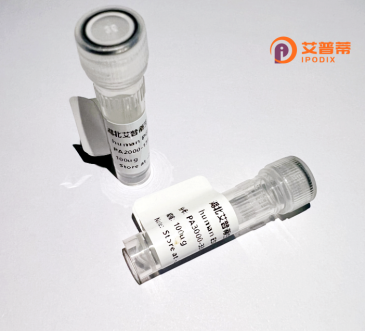
| 纯度 | >90%SDS-PAGE. |
| 种属 | Human |
| 靶点 | ORC4L |
| Uniprot No | O43929 |
| 内毒素 | < 0.01EU/μg |
| 表达宿主 | E.coli |
| 表达区间 | 1-436 aa |
| 活性数据 | MSSRKSKSNS LIHTECLSQV QRILRERFCR QSPHSNLFGV QVQYKHLSEL LKRTALHGES NSVLIIGPRG SGKTMLINHA LKELMEIEEV SENVLQVHLN GLLQINDKIA LKEITRQLNL ENVVGDKVFG SFAENLSFLL EALKKGDRTS SCPVIFILDE FDLFAHHKNQ TLLYNLFDIS QSAQTPIAVI GLTCRLDILE LLEKRVKSRF SHRQIHLMNS FGFPQYVKIF KEQLSLPAEF PDKVFAEKWN ENVQYLSEDR SVQEVLQKHF NISKNLRSLH MLLMLALNRV TASHPFMTAV DLMEASQLCS MDSKANIVHG LSVLEICLII AMKHLNDIYE EEPFNFQMVY NEFQKFVQRK AHSVYNFEKP VVMKAFEHLQ QLELIKPMER TSGNSQREYQ LMKLLLDNTQ IMNALQKYPN CPTDVRQWAT SSLSWL |
| 分子量 | 50.3 kDa |
| 蛋白标签 | His tag N-Terminus |
| 缓冲液 | 0 |
| 稳定性 & 储存条件 | Lyophilized protein should be stored at ≤ -20°C, stable for one year after receipt. Reconstituted protein solution can be stored at 2-8°C for 2-7 days. Aliquots of reconstituted samples are stable at ≤ -20°C for 3 months. |
| 复溶 | Always centrifuge tubes before opening.Do not mix by vortex or pipetting. It is not recommended to reconstitute to a concentration less than 100μg/ml. Dissolve the lyophilized protein in distilled water. Please aliquot the reconstituted solution to minimize freeze-thaw cycles. |
以下是关于人类重组ORC4蛋白的3篇参考文献,包含文献标题、作者及摘要概述:
---
1. **标题**:Crystal structure of the human origin recognition complex
**作者**:Bleichert, F. et al.
**摘要**:该研究通过X射线晶体学解析了人源ORC复合体的高分辨率结构,重点揭示了ORC4亚基与DNA结合的结构域及其在复制起始中的构象变化,为理解真核生物DNA复制机制提供了结构基础。
2. **标题**:Functional analysis of the human ORC4L in DNA replication and chromatin association
**作者**:Vashee, S. et al.
**摘要**:作者利用重组表达的ORC4L蛋白进行体外实验,证明其与ORC复合体其他亚基的相互作用对复制起点的识别至关重要,并发现其ATP酶活性调控复合体在染色质上的组装。
3. **标题**:Mutations in ORC4L cause Meier-Gorlin syndrome, a primordial dwarfism disorder
**作者**:Bicknell, L.S. et al.
**摘要**:研究发现ORC4L基因突变与Meier-Gorlin综合征(一种先天性侏儒症)相关,揭示了该蛋白在细胞周期调控及胚胎发育中的关键作用,突变会导致DNA复制效率显著降低。
---
以上文献覆盖ORC4L的结构、功能及疾病关联研究,如需具体年份或期刊信息可进一步补充。
**Background of Recombinant Human ORC4L Protein**
The Origin Recognition Complex (ORC) is a conserved multi-protein assembly essential for initiating DNA replication in eukaryotic cells. ORC4L, a subunit encoded by the *ORC4* gene, plays a critical role in recognizing replication origins and recruiting additional factors to form the pre-replicative complex (pre-RC). In humans, ORC4L is one of six ORC subunits (ORC1-6) that coordinate the cell cycle-dependent licensing of replication origins. This process ensures precise DNA duplication during S phase, maintaining genomic stability.
Recombinant ORC4L protein is produced using genetic engineering techniques, enabling studies on its structure, function, and interactions. Research has shown that ORC4L binds ATP and collaborates with ORC1 and ORC5 to stabilize the ORC core. Dysregulation of ORC4L is linked to developmental disorders, such as Meier-Gorlin syndrome, and cancers, where replication errors contribute to genomic instability.
Studying recombinant ORC4L facilitates exploration of replication initiation mechanisms, drug targeting for replication-related diseases, and understanding cell cycle regulation. Its biochemical characterization continues to reveal insights into DNA replication fidelity and cell proliferation control.
×